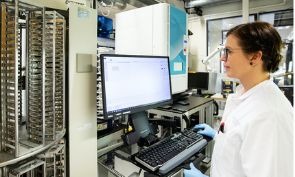
Advanced cell-based models have grown in popularity for drug testing applications. The use of nanofibrillar cellulose hydrogels has enabled organoid drug screening that is largely animal free, automation friendly and cheap to run, as outlined by Tijmen Booij, Christian Stirnimann and Tony Kiuru.
Simplified biological models, such as two-dimensionally cultured immortalised cell lines, have played an important role in the identification and evaluation of drug targets as well as the elucidation of cellular signalling pathways. However, the correct prediction of in vivo drug responses based on in vitro assays using these models is challenging. In recent years, alternative in vitro assays have been developed that better mimic pathophysiology, including three-dimensional cell culture models of multicellular tumour spheroids and (patient-derived) organoids, and organ-on-a-chip technology, all of which are gaining in popularity for large-scale drug testing.
Automation and miniaturisation with traditional matrices
Organoids are typically cultured in a gel-like matrix that supports their three-dimensional organisation, offering a more in vivo-like tissue architecture. An animal-derived basement membrane extractive (BME) can maintain tissue integrity, serve as a scaffold and a barrier for cells and molecules, and transduce mechanical signals. However, its complex composition and properties also pose challenges for automation and assay miniaturisation.
Animal-derived BMEs are only liquid at temperatures between about 4 and 10°C, making automated dispensing at room temperature difficult; premature polymerisation is likely to occur over time, causing blockages and sampling of incorrect volumes. Equipment can be moved to a cold environment to counteract these issues, and pre-cooled before handling the matrix, but this is not ideal for complete automation of the screening procedure. Another option is to equip liquid handling platforms with actively cooled reservoirs to prevent polymerisation but, again, this is not optimal and may result in condensation or a buildup of ice.
Following on from this stage, a higher temperature polymerisation step is required for gel formation. This can also be problematic if the organoids or cells are embedded within the gel as they can potentially sink prior to cell seeding, or during polymerisation, causing non-uniform distribution across plates and reproducibility issues. It is crucial that the BME-cell mixture is kept in constant motion by stirring, although this can be a stress factor for sensitive cells. BME left in the dispensing equipment once the assay is complete can also polymerise and cause blockages; classical pipette tip-based dispensing systems may be preferable.
The animal-free, automation-friendly option
Wood-derived nanofibrillar cellulose hydrogels are an ideal alternative to BMEs, as their physical properties make them amenable to automation, helping to overcome the challenges of reproducibility and scalability.
They do not require cooling or polymerisation, and cells remain in suspension before and during dispensing to the target plates, avoiding damage to cells from stirring. They are also ideal for assay miniaturisation, and for optimising both culture conditions and automated protocols.
This was demonstrated in a recent publication describing the optimisation of a screening set-up for two hepatocellular carcinoma organoid lines, where a traditional automated plate preparation using an animal-derived BME had been miniaturised to a 384-well plate format.
Animal-derived BMEs are only liquid at temperatures between about 4 and 10°C, making automated dispensing at room temperature difficult
However, the use of traditional matrices and pipette tips prevented further miniaturisation [1]. Substituting nanofibrillar cellulose hydrogel for the BME enabled a screening workflow that was almost entirely free of animal products – these were still required for organoid expansion – largely preventing issues with reproducibility and batch-to-batch variations. The assay was suitable for a 1,536-well plate format, and the use of pipette tips was eliminated. The only equipment required for plate preparation was a digital dispenser and an automated plate centrifuge. Cooling and stirring were no longer necessary.
Cost-efficient workflows
Choosing nanofibrillar cellulose hydrogel in this example enabled miniaturisation of the process into a 1,536-well format, making the organoid screening process far more efficient. The use of a digital dispenser for both organoids and hydrogel reduced the equipment dead volumes to less than 1 ml, compared to more than 10 ml for traditional pipetting-based approaches, saving on expensive materials. The cost per plate was reduced tenfold compared to the previous methodology.
Summary
Nanofibrillar cellulose hydrogels have been shown to be ideal for automated screening of hepatocellular carcinoma organoids, overcoming the limitations of animal-derived matrices to allow further miniaturisation of an existing BMEbased assay from 384- to 1,536-well formats. The revised methodology also eliminates the use of pipette tips and most animal-derived products, providing a more standardised screening set-up that uses well-defined materials, with few devices required. The screening cost per sample is significantly reduced, even taking capital investment in equipment into account, as the devices used are commonly available in many automation facilities, and overall, this choice of matrix represents a very practical and cost effective alternative to traditional products.
Tijmen Booij and Christian Stirnimann are based at ETH Zurich core facility NEXUS Personalized Health Technologies, Switzerland ethz.ch/de.html
Tony Kiuru works for UPM Biomedicals upm.com
References:
1 Stirnimann, C. and Booij, T. (2022) Miniaturising organoid drug screens using nanofibrillar cellulose hydrogels

